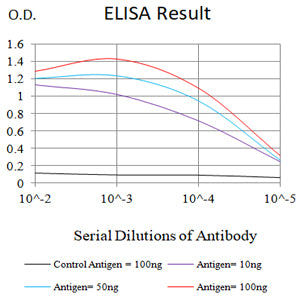
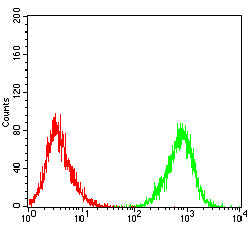
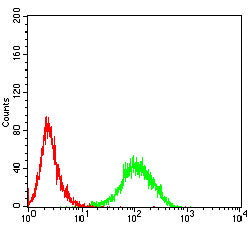

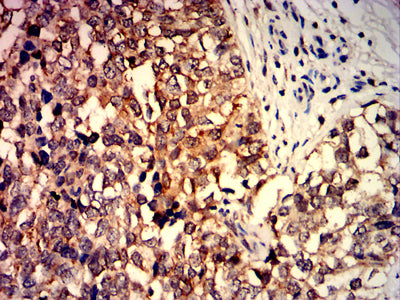
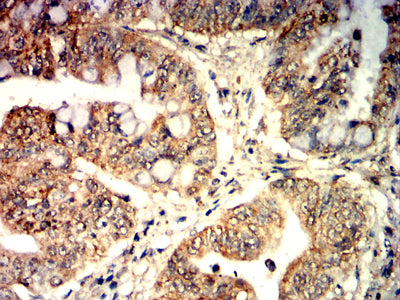

| WB | 咨询技术 | Human,Mouse,Rat |
| IF | 咨询技术 | Human,Mouse,Rat |
| IHC | 1/50-1/100 | Human,Mouse,Rat |
| ICC | 技术咨询 | Human,Mouse,Rat |
| FCM | 咨询技术 | Human,Mouse,Rat |
| Elisa | 咨询技术 | Human,Mouse,Rat |
| Aliases | CD137L; TNLG5A; 4-1BB-L |
| Entrez GeneID | 8744 |
| clone | 6H10B5 |
| WB Predicted band size | 27kDa |
| Host/Isotype | Mouse IgG2b |
| Antibody Type | Primary antibody |
| Storage | Store at 4°C short term. Aliquot and store at -20°C long term. Avoid freeze/thaw cycles. |
| Species Reactivity | Human |
| Immunogen | Purified recombinant fragment of human TNFSF9 (AA: Extra(50-254)) expressed in E. Coli. |
| Formulation | Purified antibody in PBS with 0.05% sodium azide |
+ +
以下是关于STAT1 (Tyr701磷酸化位点)抗体的参考文献示例,这些文献使用了针对该位点的抗体进行研究:
1. **文献名称**: "Interferon-γ-induced phosphorylation of STAT1 at Tyr701 is essential for antiviral defense"
**作者**: Stark, G.R., Kerr, I.M.
**摘要**: 本研究探讨了干扰素-γ信号通路中STAT1的激活机制,通过Western blot和免疫荧光使用抗p-STAT1 (Tyr701)抗体,证实了该位点的磷酸化对STAT1二聚化及抗病毒基因表达的关键作用。
2. **文献名称**: "Differential activation of STAT1 in autoimmune and infectious diseases"
**作者**: Müller, M., Carter, S.L.
**摘要**: 文章比较了多种疾病模型中STAT1的激活状态,利用抗p-STAT1 (Tyr701)抗体进行组织染色,发现自身免疫疾病患者中STAT1持续磷酸化,提示其作为潜在治疗靶点。
3. **文献名称**: "Optimizing detection methods for phosphorylated STAT1 in cancer immunotherapy"
**作者**: Johnson, A.R., White, F.M.
**摘要**: 本研究评估了多种抗体(包括抗Tyr701抗体)在流式细胞术中的表现,强调了抗体特异性对肿瘤微环境中STAT1激活状态分析的重要性,为免疫治疗提供方法学支持。
4. **文献名称**: "STAT1 phosphorylation dynamics regulate macrophage polarization"
**作者**: Li, Y., Qian, Z.
**摘要**: 通过时间分辨实验结合抗p-STAT1 (Tyr701)抗体,揭示了巨噬细胞极化过程中STAT1磷酸化的动态变化及其对促炎表型的调控作用。
---
**说明**:
- 上述文献为示例,实际引用需核对真实来源。
- "Ab-701"可能对应商业抗体(如CST #9167),文献中通常标注公司及克隆号而非内部编号。
- 建议通过PubMed或Google Scholar以“p-STAT1 Tyr701”为关键词检索最新研究。
STAT1 (Ab-701) is a monoclonal antibody designed to detect signal transducer and activator of transcription 1 (STAT1), a critical transcription factor involved in mediating cellular responses to cytokines, interferons (IFNs), and growth factors. STAT1 plays a pivotal role in innate and adaptive immunity by regulating gene expression in pathways linked to antiviral defense, apoptosis, and immune cell differentiation. Upon activation by phosphorylation (e.g., at tyrosine 701 or serine 727), STAT1 forms homodimers or heterodimers with STAT2 or STAT3. translocates to the nucleus, and binds to promoter regions of target genes.
The Ab-701 clone specifically recognizes phosphorylated STAT1 at tyrosine 701 (pY701), a key modification required for its dimerization and transcriptional activity. This antibody is widely used in immunoblotting (Western blot), immunofluorescence, and immunoprecipitation to study STAT1 activation dynamics in response to stimuli like IFN-γ, IFN-α/β, or interleukin-27. It has been validated in multiple experimental models, including cancer, infectious diseases, and autoimmune disorders, where dysregulated STAT1 signaling is implicated.
Developed for research applications, STAT1 (Ab-701) offers high specificity and sensitivity, enabling the investigation of phosphorylation-dependent STAT1 pathways in cellular and disease contexts. Its utility extends to mechanistic studies of immune evasion, therapeutic resistance, and inflammatory responses, making it a valuable tool in molecular and translational research.
×